Grace Robert. Advanced Blowout and Well Control
Подождите немного. Документ загружается.

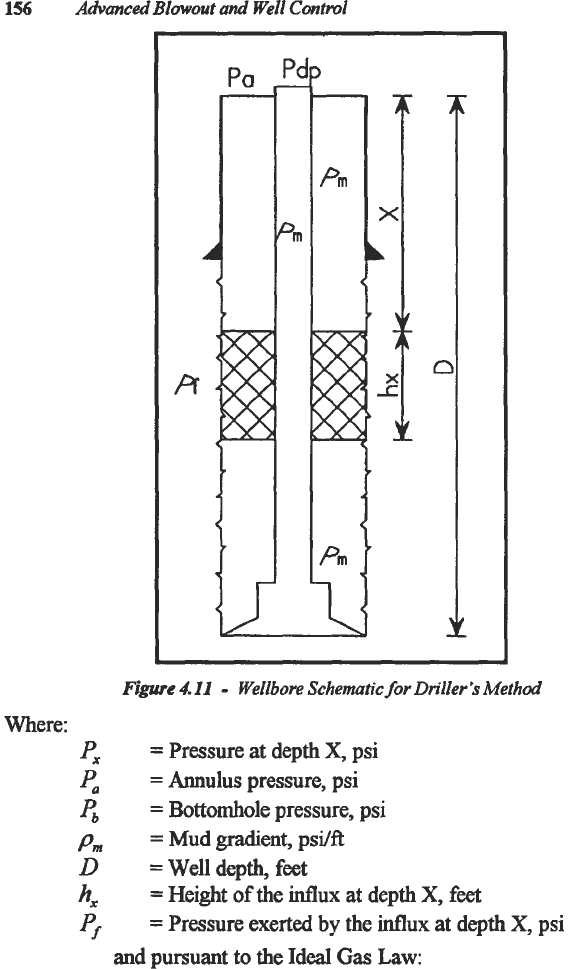
156
Advanced
Blowout
and
Well
Control
C
Figure
4.
I1
-
Wellbore Schematic
for
Driller’s Method
Where:
4
=
Pressure at depth
X,
psi
e4
=
Annulus pressure, psi
pb
=
Bottomhole pressure, psi
PIN
=
Mud went, psi/ft
D
=Well depth,
feet
hx
Pf
=
Height
of
the influx at depth
X,
feet
=
Pressure exerted
by
the influx at depth
X,
psi
and pursuant
to
the Ideal
Gas
Law:
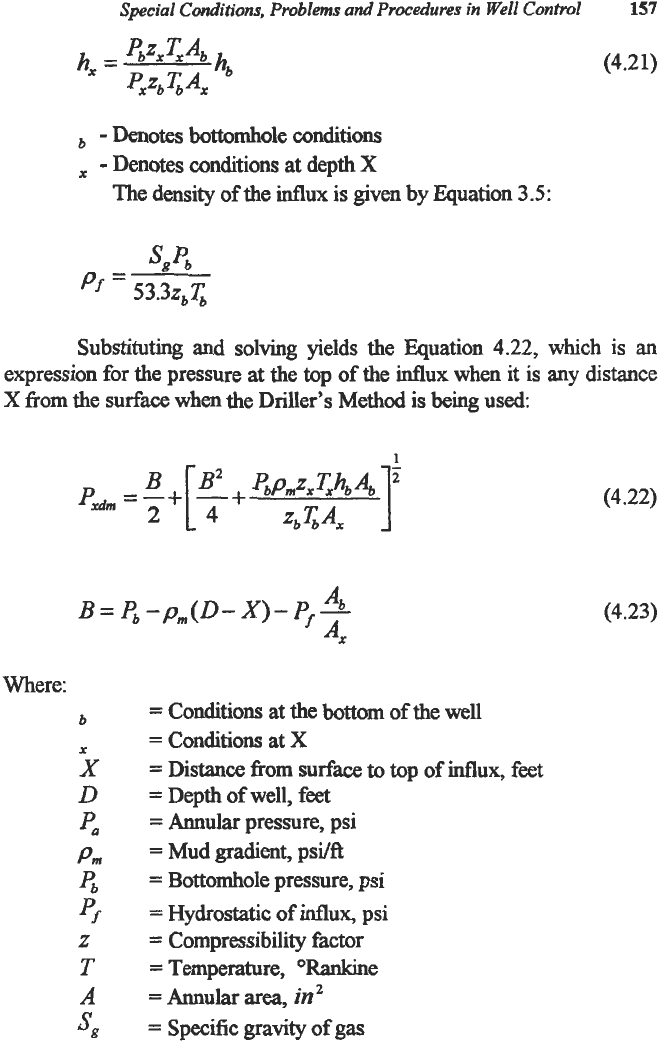
Special
Conditions,
Problems
and
Procedures
in
Well
Control
157
Pz
TA
hx=
bxx
hb
eZb
T6
Ax
(4.21)
-
Denotes
bottomhole conditions
-
Denotes conditions at depth
X
The density of the influx is given by Equation
3.5:
Substituting and solving yields the Equation
4.22,
which is
an
expression for the pressure at the top of the
influx
when
it
is any distance
X
from the
surfw
when the Driller's Methad
is
being
used:
B
=
pb
-p,(D-
X)
-
Pf
-
Ab
Ax
Where:
b
x
X
D
Pm
p*
pb
p.
z
T
A
s&?
=
Conditions
at
the bottom of the well
=
Conditions at
X
=
Distance
from
surfw
to
top
of
influx,
feet
=
Depth of well, feet
=
Annular pressure, psi
=
Mud gradient, psi/ft
=
Bottomhole pressure, psi
=
Hydrostatic of influ% psi
=
Compressibility factor
=
Temperature, 'Rankine
=
~nnular area,
in2
=
Specific gravity
of
gas
(4.22)
(4.23)
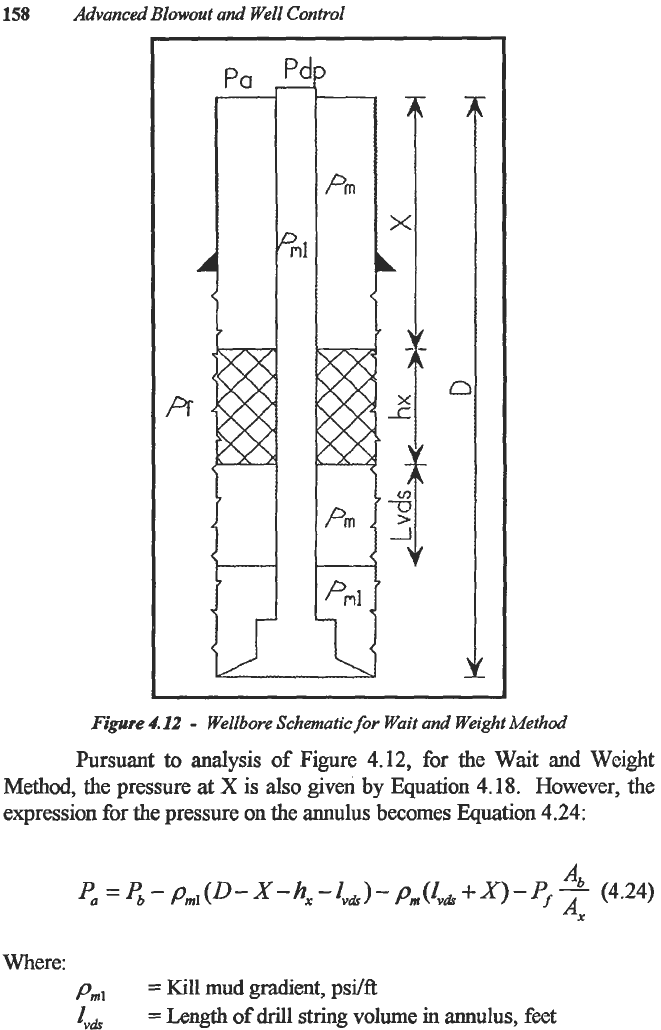
158
Advanced
Blowout
and Well
Control
I
c
1
Figure
4.12
-
Wellbore Schematic
for
Wait and Weight
Method
Pursuant
to
analysis of Figure 4.12, for the
Wait
and
Weight
Method,
the pressure at
X
is also given by Equation 4.18. However,
the
expression for the pressure on the
annulus
becomes Equation 4.24:
Ab
Ax
P,
=
pb
-
p,,(D-
X-hx
-Zvk)-
pm(Zvh
+
X)-
P
-
(4.24)
Where:
Pml
Zvb
=
Kill
mud
gradient, psi/f€
=
Length
of
drill
string volume
in
annulus,
feet
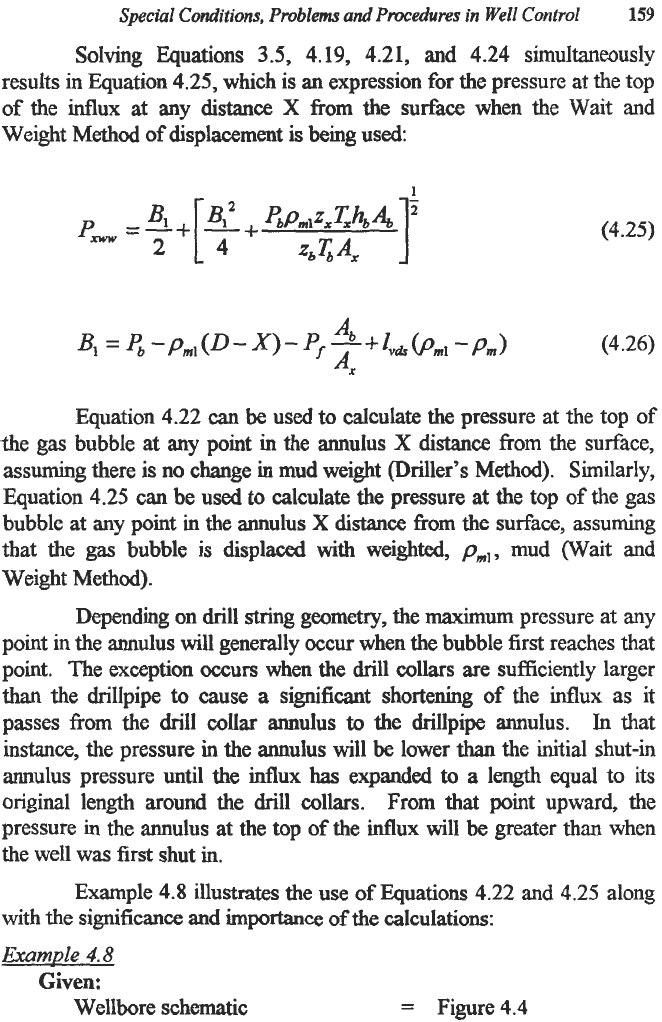
Special
Conditions,
Problems
and
Procedures
in
Well
Control
159
Solving Equations
3.5,
4.19, 4.21,
and
4.24 simultaneously
results in Equation
4.25,
which is
an
expression
for
the pressure at the top
of
the influx
at
any
distance
X
from the surface when the Wait
and
Weight
Method
of
displacement
is
being used:
(4.25)
(4.26)
Equation
4.22
can
be
used to calculate the pressure at the top of
the
gas
bubble
at
any point in the annulus
X
distance from the surface,
assuming there is no change in mud weight (Driller's
Method).
Similarly,
Equation 4.25
can
be used to calculate the pressure at the top of the gas
bubble at
any
point in the annulus
X
distance from the surface,
assuming
that the gas bubble
is
displaced with weighted,
pml,
mud (Wait
and
Weight Method).
Depending on
drill
string geometry, the
maximum
pressure at any
point
in
the annulus will generally occur when the bubble first reaches that
point. The exception occurs when the drill collars are sufficiently larger
than
the drillpipe
to
cause
a
significant shortening of the
influx
as it
passes from the drill collar annulus
to
the drillpipe annulus.
In
that
instance, the pressure
in
the annulus will
be
lower
than
the initial shut-in
annulus pressure until the influx
has
expanded
to
a
length equal to its
original length around the drill collars. From that point upward, the
pressure
in the annulus at the top
of
the influx will be greater than when
the well
was first shut in.
Example 4.8 illustrates the use
of
Equations 4.22
and
4.25
along
with
the
significance
and
importance
of
the calculations:
Example
4.8
Given:
Wellbore schematic
=
Figure4.4
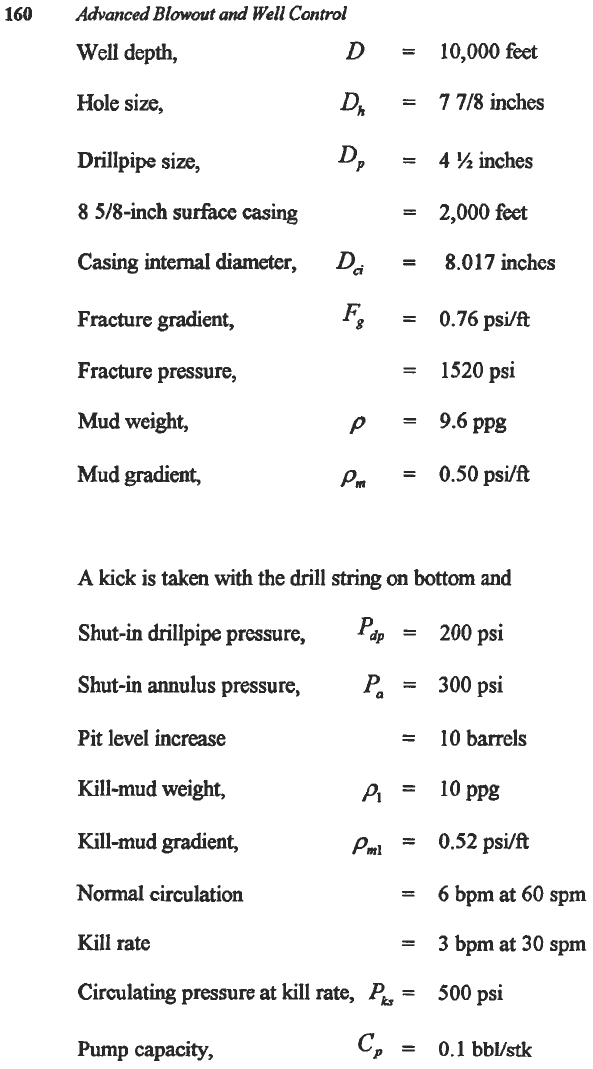
160
Advanced Blmt
and
Well Control
Well depth,
D
=
10,OOOfeet
Hole size,
D,,
=
7
718
inches
Drillpipe size,
Dp
=
4
%inches
8
5/8-hch surface
wing
=
2,OOOfeet
Casing internal diameter,
D~
=
8.017
inches
Fracture
gradient,
<
=
0.76psVfi
Fracture pressure,
=
1520psi
Mud weight,
P
=
9-6PPg
Mud
gradient,
Pnl
=
0.50psi/fi
A
kick
is
taken
with
the drill
string
on
bottom
and
Shut-in drillpipe pressure,
pdp
=
200
psi
Shut-in annulus pressure,
P,
=
300psi
Pit level increase
=
10 barrels
Kill-mud weight,
h
=
1oPPg
Kill-mud gmhent,
p,,,,
=
0.52psilfi
Nod
circulation
=
6 bpm
at
60 spm
Kill rate
=
3
bpm at
30
spm
Circulating pressure at kill
rate,
Pk,
=
Pump capacity,
cp
=
0.1
bbVstk
500
psi
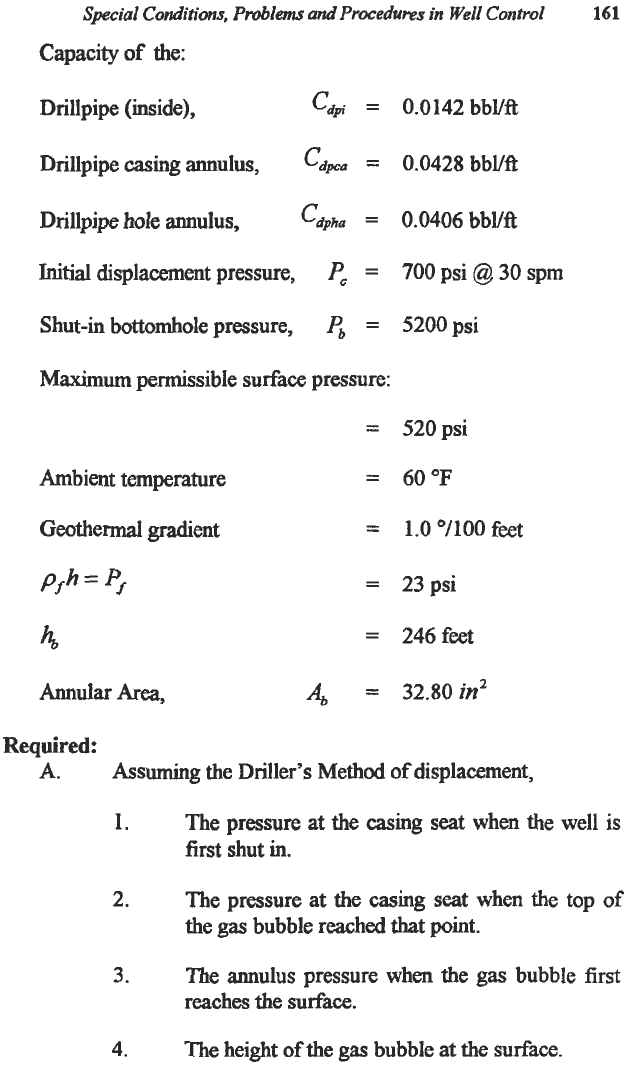
Special Conditions, Problems
and
Procedures
in
Well
Control
161
Capacity
of
the:
Drillpipe (inside),
cw
=
0.0142bbVft
Drillpipe casing annulus,
cdm
=
0.0428bbVft
Drillpipe hole annulus,
cdpha
=
0.0406 bbVft
Initial
displacement pressure,
P,
=
700
psi
@
30
spm
Shut-in bottomhole pressure,
pb
=
5200 psi
Maximum
permissible surface pressure:
=
52Opsi
Ambient temperature
=
60°F
Geothermal went
=
1.0
"/loo
feet
Pfh
=
Pf
=
23psi
4
=
246feet
Annular
Area,
4
=
32.80
in2
Required:
A.
Assuming
the Driller's Method of displacement,
1.
The pressure
at
the
casing
seat when the well
is
first shut in.
2.
The pressure at the casing seat when the top
of
the gas bubble reached that point.
3.
The annulus pressure when the gas bubble
first
reaches the surface.
4.
The height
of
the
gas
bubble at the surface.
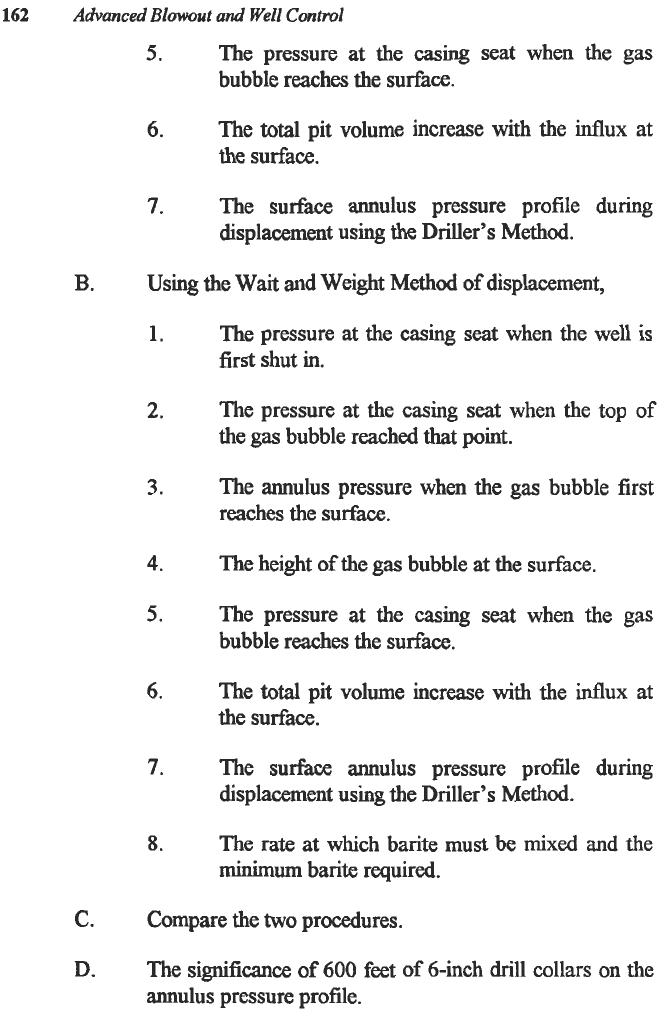
162
Advanced Blowout
and
Well Control
5.
The pressure
at
the
casing
seat when the gas
bubble reaches the sufice.
The
total
pit volume increase with the influx at
the surface.
6.
7.
The surface annulus pressure profile during
displacement using the Driller's Method.
B.
Using
the Wait and Weight Method
of
displacement,
1.
2.
3.
4.
5.
6.
7.
8.
The pressure at the casing seat when the well is
first shut in.
The pressure at the casing seat when the top of
the
gas
bubble reached that point.
The annulus pressure when the gas bubble first
reaches the surf".
The height
of
the
gas bubble
at
the surface.
The pressure at the casing seat when the gas
bubble reaches the surface.
The
total
pit volume increase with
the
influx at
the surface.
The surface annulus pressure profile during
displacement using the Driller's
Method.
The
rate
at
which barite must be
mixed
and
the
minimum barite required.
C. Compare the
two
procedures.
D.
The significance
of
600
feet
of
6-inch drill collars on the
annulus pressure profile.
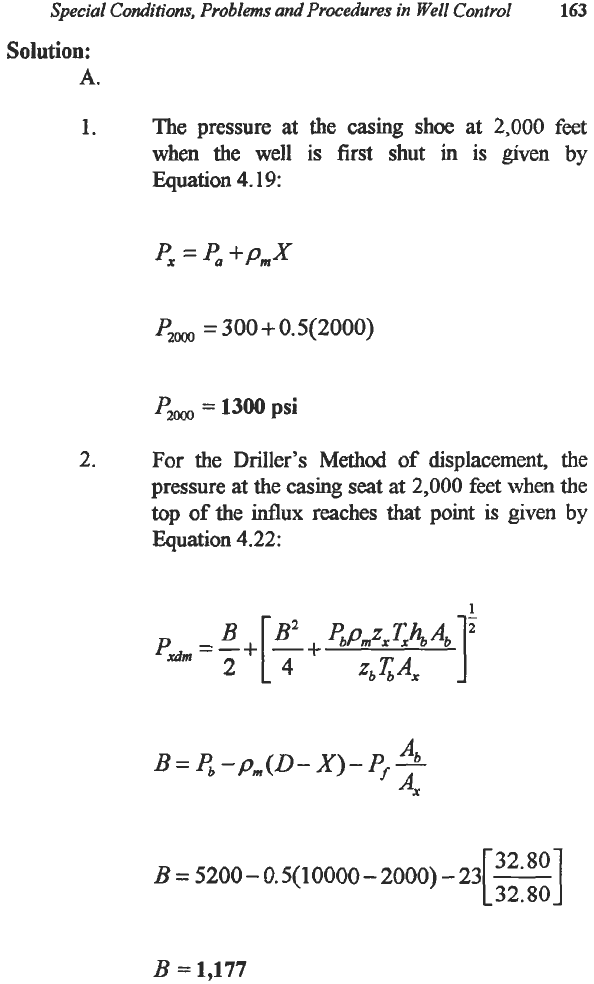
Special Conditions, Problems and Procedures in Well Control
163
Solution:
A.
1.
The pressure at the casing
shoe
at
2,000
feet
when the well
is
first shut
in
is
given
by
Equation
4.19:
pZooo
=
300
-t-
0.5(2000)
pZm
=
1300
psi
2.
For the Driller’s
Method
of displacement, the
pressure at the casing seat at
2,000
feet when the
top
of
the influx reaches that point
is
given
by
Equation
4.22:
Ab
B
=
8
-pm(D
-
X)
-
PI
-
4
B
=
5200
-
0.5(
10000
-
2000)
-
23
-
[:::::I
B
=
1,177
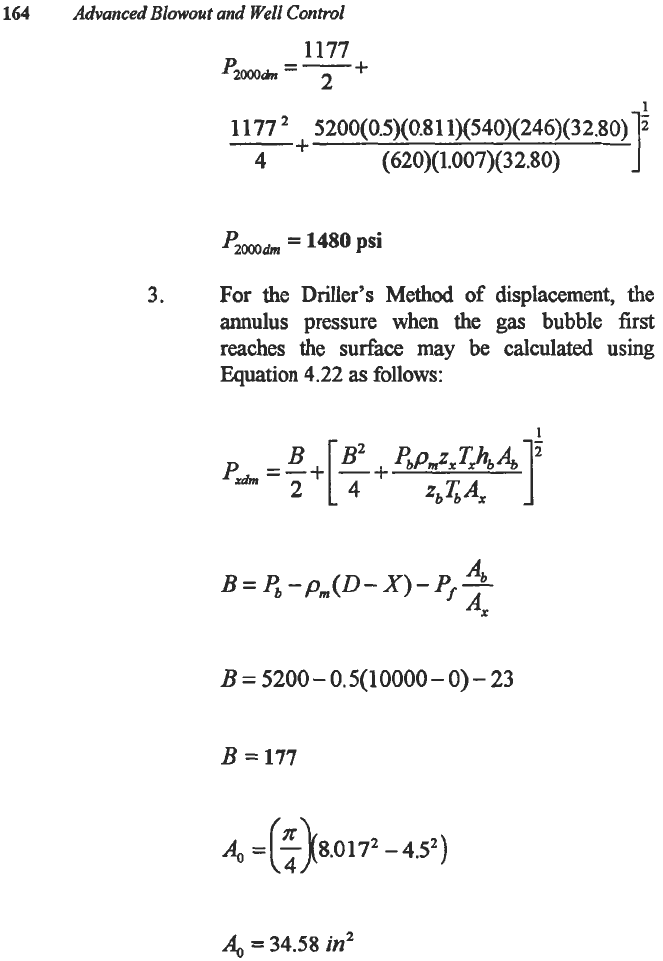
164
Advanced
Blowout
and Well Contml
+
1177
P2mh
=
2
1177
’
5200(0.5)(0.811)(540)(246)(32.80)
(620)(1.007)(3 2.80)
+
4
PzoOoh
=
1480
psi
3.
For
the Driller’s Method
of
displacement, the
annulus pressure when the
gas
bubble first
reaches the surfixe may be calculated
using
Equation 4.22
as
follows:
Ab
B
=
<
-p,,,(D-
X)
-
Pf
-
AX
B
=
5200-
0.5(
10000
-
0)
-
23
B
=
177
A,,
=
(:)(8.01 72
-
4.5’)
4
=
34.58
in’
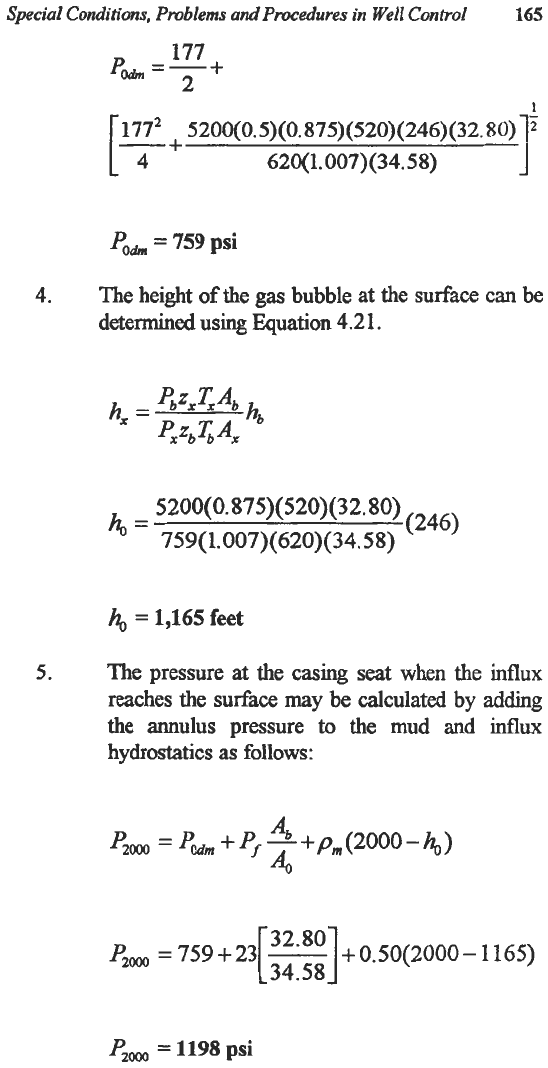
Speck11
Conditions,
Pdlems
and
Pmdums
in
Well
Control
165
177
2
Ph=-+
1
177*
5200(0.5)(0.875)(520)(246)(32.80)1~
620(1.007)(34.58)
1
P-
=
759
psi
4.
The height
of
the
gas
bubble at the surface
can
be
determined using Equation
4.2
1.
(246)
5200(0.875)(520)(32.80)
'
=
759(1.007)(620)(34.58)
h,
=
1,165
feet
5.
The pressure
at
the
casing
seat
when
the
influx
reaches the surface
may
be calculated
by
adding
the annulus pressure to the mud and influx
hydrostatics
as
follows:
pzOo0
=
Podrn
+PI
-+pm(20O0-h,)
4
A0
ern
=759+23
-
32J30
+
0.50(2000-
1165)
[
34.581
Pm
=
1198
psi
